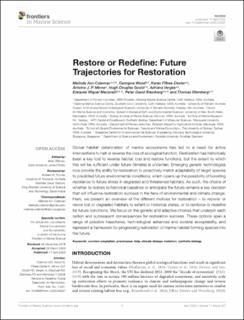| dc.contributor.author | Coleman, Melinda Ann | |
| dc.contributor.author | Wood, Georgina | |
| dc.contributor.author | Filbee-Dexter, Karen | |
| dc.contributor.author | Minne, Antoine J.P. | |
| dc.contributor.author | Goold, Hugh Douglas | |
| dc.contributor.author | Vergés, Adriana | |
| dc.contributor.author | Marzinelli, Ezequiel Miguel | |
| dc.contributor.author | Steinberg, Peter David | |
| dc.contributor.author | Wernberg, Thomas | |
| dc.date.accessioned | 2020-10-15T13:26:56Z | |
| dc.date.available | 2020-10-15T13:26:56Z | |
| dc.date.created | 2020-05-21T17:24:12Z | |
| dc.date.issued | 2020 | |
| dc.identifier.citation | Frontiers in Marine Science. 2020, 7 1-12. | en_US |
| dc.identifier.issn | 2296-7745 | |
| dc.identifier.uri | https://hdl.handle.net/11250/2683141 | |
| dc.description.abstract | Global habitat deterioration of marine ecosystems has led to a need for active interventions to halt or reverse the loss of ecological function. Restoration has historically been a key tool to reverse habitat loss and restore functions, but the extent to which this will be sufficient under future climates is uncertain. Emerging genetic technologies now provide the ability for restoration to proactively match adaptability of target species to predicted future environmental conditions, which opens up the possibility of boosting resistance to future stress in degraded and threatened habitats. As such, the choice of whether to restore to historical baselines or anticipate the future remains a key decision that will influence restoration success in the face of environmental and climate change. Here, we present an overview of the different motives for restoration – to recover or revive lost or degraded habitats to extant or historical states, or to reinforce or redefine for future conditions. We focus on the genetic and adaptive choices that underpin each option and subsequent consequences for restoration success. These options span a range of possible trajectories, technological advances and societal acceptability, and represent a framework for progressing restoration of marine habitat forming species into the future. | en_US |
| dc.language.iso | eng | en_US |
| dc.title | Restore or redefine: Future trajectories for restoration | en_US |
| dc.type | Peer reviewed | en_US |
| dc.type | Journal article | en_US |
| dc.description.version | publishedVersion | en_US |
| dc.source.pagenumber | 1-12 | en_US |
| dc.source.volume | 7 | en_US |
| dc.source.journal | Frontiers in Marine Science | en_US |
| dc.identifier.doi | 10.3389/fmars.2020.00237 | |
| dc.identifier.cristin | 1812069 | |
| cristin.ispublished | true | |
| cristin.fulltext | original | |
| cristin.qualitycode | 1 | |
